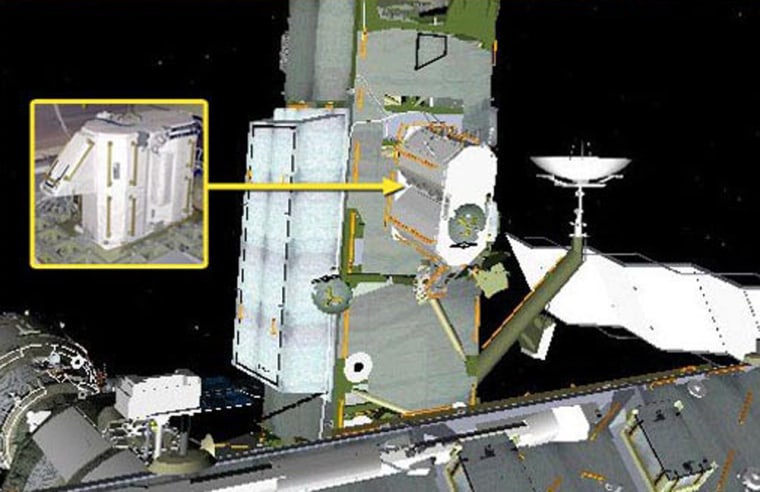The three-man crew aboard the international space station will do a little housekeeping during a spacewalk next week to make way for future expansion of the laboratory.
On July 23, Expedition 15 crewmember Clayton Anderson will journey outside of the space station to throw two large hunks of unneeded equipment towards Earth, officials said during a press conference today at NASA's Johnson Space Center in Houston, Texas.
"This is the first time we've ever done a jettison quite like this on the space station," said Bob Dempsey, NASA's lead flight director for Expedition 15, adding that smaller jettisons have been performed on past ISS and Hubble Space Telescope missions.
During the upcoming spacewalk, Anderson will jettison a 1,400-pound (635-kilogram) refrigerator-sized container of ammonia, or Early Ammonia Servicer, away from the station at a gentle pace of one mile per hour. He'll also toss a 212-pound (96-kilogram) stanchion used to attach a camera to the space laboratory toward the Earth.
Dempsey explained that discarding the equipment during an extravehicular activity, rather than shipping it back to Earth via a NASA shuttle, was the best choice because of time and space constraints.
"It's not a decision that's made lightly. Besides the fact that it might have some use in the future, it provides space debris that could later impact the space station," Dempsey said. He noted that moving the equipment around will be necessary to make room for additions and repairs to the ISS during future shuttle missions.
Once tossed from the space station, both objects will be tracked by NASA for almost a year until they begin entering the atmosphere. The agency expects the stanchion to burn up completely, but think pieces of the ammonia tank may reach the Earth's surface.
"We don't know where it's going to land yet," Dempsey said, but added that it will likely be over the ocean and shouldn't damage satellites or other spacecraft in orbit.
In addition to tossing the unneeded equipment overboard, cosmonaut Fyodor Yurchikhin, Expedition 15's commander, will join Anderson on the spacewalk with cleaning and repair duties. Flight engineer Oleg Kotov will control the robotic arm to shuttle the astronauts around outside of the station.
When the EVA is complete, the space station will be boosted to a higher orbit to prepare for docking with Endeavour early next month, as well as to avoid dangerous encounters with the ejected objects.
"We know the crew's ready," said Daryl Schuck, NASA's lead EVA officer for Expedition 15, adding that Anderson and Yurchikhin were trained on Earth for the jettisoning procedure. "We've got confidence in our approach to this and confidence in our crew."
